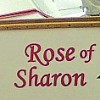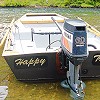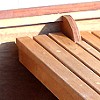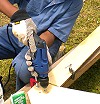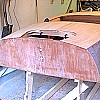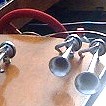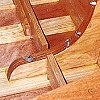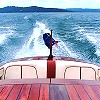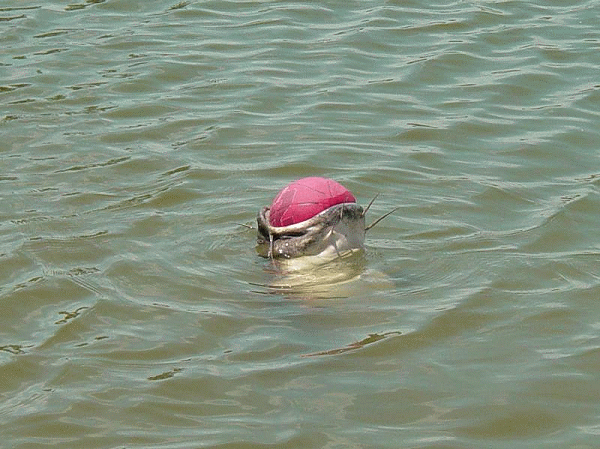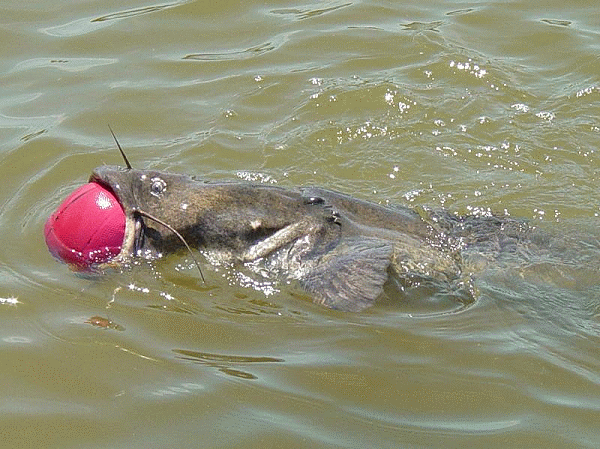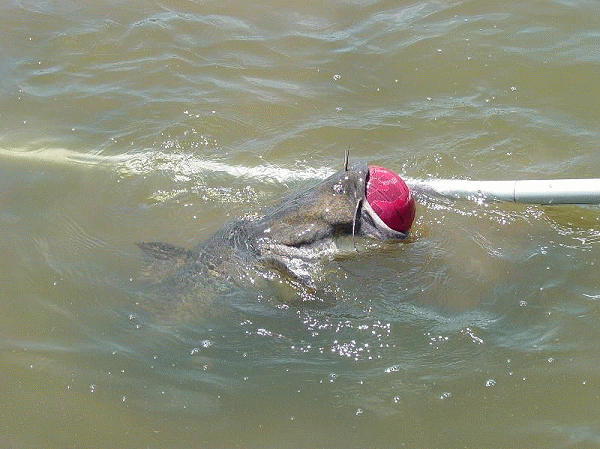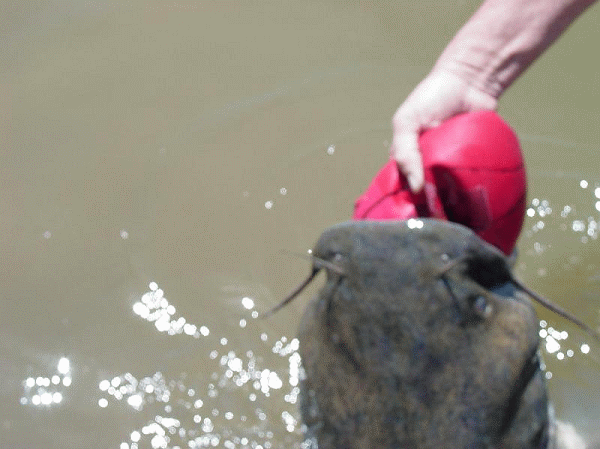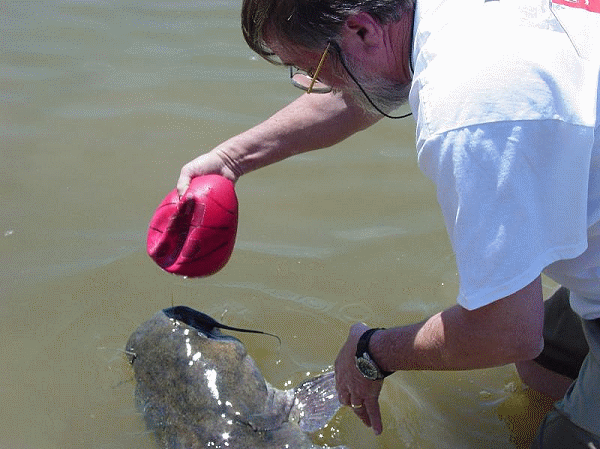

A place to share YOUR boat building story
Glen-L Marine Designs - 9152 Rosecrans Ave. - Bellflower, CA 90706
 In this
issue
In this
issue
-
"Like Sugar" by Tim
Major
-
Glen-L Boatbuilder of the
Month
-
Building the Glen-L Zip by Paul
Vernes
-
Designer's Notebook: THINK
before you fiberglass...
-
Oars (the long and short of
it) by ArtDeco
-
Photos posted since the last
WebLetter...
-
A $10 - 10 Minute Steam Box by
Jack Dice
-
Shop Talk: Cheap Insurance and
More...
-
Recent email
-
A Fish Story
GLEN-L Update
- Summer is in full swing here in the Northern Hemisphere. We hope you're all making the time to get out on the water in the boats you've so lovingly crafted, or using the extra time the sun is out this time of year to make progress on the boat you're currently building. Whichever it is for you, we know that you're experiencing the kind of pure enjoyment that is only known by someone who is building and/or using a boat which they put together with their own hands.
-
- Over on the Glen-L Boatbuilder Forum talk has already turned to "So, what's for dinner?" at the upcoming 2010 Gathering of Boatbuilders. Brunswick Stew, Low Country Boil, Alaskan Salmon, Butt Roast, Pot of Gold, Chili Cook-off, Country Breakfasts, even ELK are being discussed. If you're new to Glen-L or the annual Gathering of Boatbuilders, learn more about this fun, free event and seriously think about joining us this September 24 - 26 at Lake Nickajack, Tennessee. I mean, great people, floating cabins, beautiful boats, and ELK!
Until next month . . .
Editor
"Like Sugar"
by Tim Major, Sydney, Australia
"...I HAD NO INTEREST IN BOATS..."
Until six months ago I had no
interest in boats whatsoever. My wife Jane has long enjoyed
sailboats from a time prior to us coming together around ten
years ago so she has periodically raised the subject of boat
ownership. Well, as I said, the interest has never been there
for me nor did I feel comfortable relying on the elements to
get me anywhere, so when the old "boat chestnut"
was raised again recently I gave the notion further reluctant
thought and conceded to the possibility of owning a boat we
could enjoy together, enabling us to spend leisure time
exploring Sydney's waterways. My only stipulations were
that the boat have no sail, be of classic style and powered
by an inboard V8 engine, pretty simple really, a sports car
on water.
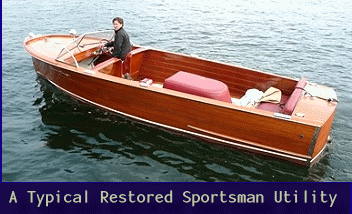 To her
credit, Jane took the ball and ran with it. We attended an
auction in early December 2009 that had some wooden boats up
for grabs including a 1949 22' Chris Craft Sportsman
utility and a classic 1961 16' Hammond clinker ski boat,
both in need of some attention. Neither boat came our way
(fortuitously in retrospect) but the experience stirred my
interest and as I looked over these boats again after the
auction I said to Jane "I'm sure that I could build
one of these things".
To her
credit, Jane took the ball and ran with it. We attended an
auction in early December 2009 that had some wooden boats up
for grabs including a 1949 22' Chris Craft Sportsman
utility and a classic 1961 16' Hammond clinker ski boat,
both in need of some attention. Neither boat came our way
(fortuitously in retrospect) but the experience stirred my
interest and as I looked over these boats again after the
auction I said to Jane "I'm sure that I could build
one of these things".
The decision to actually look at buying a boat to restore
was, in part, due to my need for a project outside work to
focus on and as we drove home from the auction I became more
certain of the fact that actually building my own classic
timber powerboat would be an extraordinary experience.
The ensuing internet search for boat plans culminated in the
discovery of Glen-L Designs and with time spent
examining the many build options the Monaco had immediate appeal along with
the possibility of perhaps building the utility version. The
utility option will be decided on when I see how that 5.7
litre PCM engine sits down in the boat.
Glen-L Boatbuilder of the Month
Dave Lott - Riviera
"FEW THINGS IN
THE WORLD MEASURE UP TO THE THRILL AND
SATISFACTION OF BOATING IN A BOAT THAT YOU BUILT
YOURSELF.
IT CANNOT BE DESCRIBED BUT MUST BE EXPERIENCED.
"
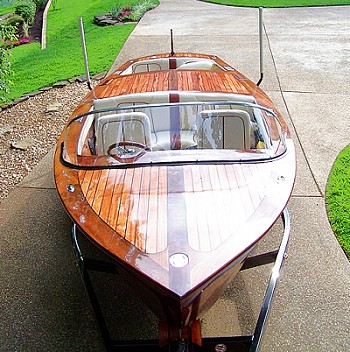 Dave Lott, of Branson, Missouri, started
building his Riviera on Fathers' Day, June 21,
2009, three years after purchasing the plans and patterns
from Glen-L Marine Designs (according to Dave, "life
happens"). His goal was to have the frames for his boat
completed by Labor Day 2009, have the hull ready to flip by
Christmas that year, and launch her on Memorial Day 2010. An
"ambitious but possible" goal…
Dave Lott, of Branson, Missouri, started
building his Riviera on Fathers' Day, June 21,
2009, three years after purchasing the plans and patterns
from Glen-L Marine Designs (according to Dave, "life
happens"). His goal was to have the frames for his boat
completed by Labor Day 2009, have the hull ready to flip by
Christmas that year, and launch her on Memorial Day 2010. An
"ambitious but possible" goal…
In the end he didn't make his goal of launching on
Memorial Day due to two setbacks:
a. Weather - "it would not stop raining which prevented
me from removing the boat from the shop across a soggy steep
lawn"
b. A "messed-up" epoxy coating - "the day
before I was planning to remove the boat and take it to have
the clear coat applied, I applied a skim coat of epoxy which
never set up. This set me back a week cleaning the hull off
and resealing"
So the launch was delayed a couple of weeks.
"…in the end, I missed a target day set a year in
advance by a few days due to 2 quirky things. I can live with
that."
Dave christened his Riviera "Midnight Cry" (see
his blog for a full explanation of how he
named the boat and his very detailed builder's log and
photos). Midnight Cry sports a PCM 5.7L V-8 Marine
EFI-multiport engine pushing out 343 Horses with a 1.23:1
down angle transmission.
It seems that Dave is very pleased with his boat. Here are
his comments after the first couple of times he took her out
on the water…
June 11, 2010: "What a BEAST. There is no doubt who is
in charge on the water now and that engine - Oh, my goodness.
It about threw my son out of the boat as we accelerated and
hit 40mph before I knew what happened. I will never have to
drink water again skiing. ALRIGHT"
June 12, 2010: "Finally, got out June 12 at 10am and
ran Midnight thru her paces. Just one word can describe her -
BEAST!!! The engine and performance is more than expected. At
21' and 3000 lbs the engine had no trouble pushing her
well over 50mph even with 5 people, full tank of fuel and 120
lbs of sand ballast. Yes, that is right - almost 1000# of
cargo. She irons out the lake with 1' - 2' chop. My
other boat could not take this but Midnight just glides over
the top of it all.
The hull apparently is very fast. I believe the fastness is
partially due to the paint by Supermarine. They claim that
the paint lacks water friction and will add speed to the
boat. I believe it is a function of both design and paint.
The result is that the engine has reduced drag and is
over-speeding. So I called upon my engine supplier who called
upon the prop manufacturer. I am using a 13.25x15. They are
increasing it to a 13.5x16 and 4 blade rather than 3. They
believe this will bring WOT back down to 5200 RPM range.
Right now WOT exceeds 6000 RPM.
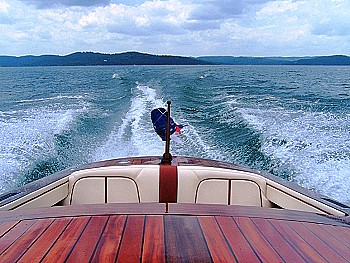 The engine punches out
of the hole in a boat length and pushes the boat over 40mph
in less than 200 ft. I call that performance. It seems to
dial into a very pleasant ride around 3200 and just hums. At
this speed the bow is slightly up. The water breaks under the
hull at the COB point. There is no spray into either cockpit
(unless I do react too fast on the throttle).
The engine punches out
of the hole in a boat length and pushes the boat over 40mph
in less than 200 ft. I call that performance. It seems to
dial into a very pleasant ride around 3200 and just hums. At
this speed the bow is slightly up. The water breaks under the
hull at the COB point. There is no spray into either cockpit
(unless I do react too fast on the throttle).
Interestingly, I have been contacted by a person interested
in buying her from me already.
And one final comment, 'Midnight is a little
boisterous" someone complained. My thoughts on that
issue - 'get over it'!"
Building the Glen-L Zip
by Paul Vernes, Bluffton, South Carolina
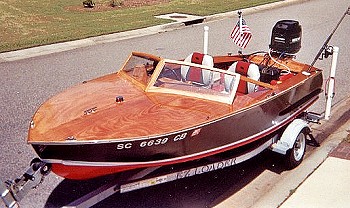 This is my boat
"River Rat", which is my interpretation of your Zip design. It is my second Glen-L, as I
built a 20' Vee Gull back in 1967, which I sailed in
Cape Cod waters.
This is my boat
"River Rat", which is my interpretation of your Zip design. It is my second Glen-L, as I
built a 20' Vee Gull back in 1967, which I sailed in
Cape Cod waters.
I started building the Zip on January 1, 2009 and launched
her August 8, 2009, so it was pretty close to 7 months; as I
am retired this was actually a relaxed project. It was great
fun, kept me out of trouble, and I am already thinking about
my next one.
My wife and I use this boat to explore and fish the
beautiful (and practically deserted) "Low Country"
waters here in the Hilton Head area of coastal South
Carolina. These are tidal waters made up of rivers,
estuaries, marshes, bays, and islands in an area that
stretches from Charleston, South Carolina all the way down to
Jacksonville, Florida. It is pristine, mostly deserted, and
abounds with fish, porpoise, fowl, beaches, and the
occasional alligator.
This planned usage of my Zip determined the open cockpit
design that allows me to move around while fishing, and the
need for a small, light, easy to trailer and launch boat that
has comfortable seating for two and protection from the
elements while day-tripping. With this setup, my wife can sit
comfortably under the bimini top and read while I fish. It is
ideal.
CONSTRUCTION
The wood I used in this boat was all obtained from local
sources. The frames and windshield are made from red oak
purchased from Lowe's, and the keel, battens, chine and
sheer are local southern yellow pine which I had to rip and
plane to size from full 1" x 8" 16-foot lumber
obtained from a local lumber yard. To do this I purchased a
portable plane from Lowe's. The plywood is ¼"
five-ply marine grade mahogany which I was fortunate to get
from a buddy here, whose boss built a cold-molded 60'
sport fisherman using the material and had six sheets left
over (which I got for half price).
Designer's Notebook: THINK before you fiberglass...
|
Oars
How long should they be |
Photos posted since the last WebLetter... |
A $10 - 10 Minute Steam Box
by Jack Dice, Stonington, Maine
I needed to bend some wood the
other day. I was installing new gunwhales and inwales on a
fiberglass skiff (an old "Plastic Pete's") that
was molded with a rounded bow as many of those fiberglass
skiffs are. The original wood had rotted away after one of
those nice canvas covered town rub rails had been installed,
collected water and never dried out. I was loath to build a
real steam box just for the time it would have taken so I
came up with this quick steam box, and it only took a few
minutes and cost only about $10.
Buy a 10' section of 4" diameter Schedule 20 PVC
pipe at your building supply yard. This pipe is used for
foundation perimeter drains in the building industry. The
pipe I got is distributed by Genova, is made by ADS, and is
labeled "30001b Triple Wall". The wall construction
of this pipe is corrugated just like a cardboard box but is
made from PVC (polyvinyl chloride). It will easily withstand
the temperature of boiling water and steam at ambient
pressure. Not only is it light but it has the great advantage
of having a high insulating value. This is desirable because
the steam will not condense as readily on the walls of the
pipe and lose its effectiveness at steaming the wood.
Avoid buying Schedule 20 or 40 PVC pipe with a solid wall as
it will not give you as effective an insulating effect. Buy a
couple of end caps that fit over the ends of the pipe to
close it off. The pipe that I purchased had a coupling molded
onto one end that took a special cap on that end. As a
cautionary note, you should never burn PVC because it gives
off toxic gasses when ignited.
Now all that is needed is a boiling vessel, a piece of old
garden hose (or suitable substitute) and a camp stove. The
boiling vessel can be anything that will hold and boil a
couple of gallons of water. I used an old five gallon
galvanized can that I found at the junk yard that might have
been used for kerosene or other solvent. An old metal gas can
will work, but be sure to rinse out all the gasoline before
putting it over a fire! A large sauce pan or Dutch oven would
work as well. If you have none of these you can buy a cheap
aluminum pot with cover for only a few bucks.
Drill a hole in the cover that is slightly smaller than the
garden hose outside diameter so that the hose can be stuffed
into it and seal itself in the hole. Drill the same diameter
hole in one of the end caps near the edge of the cap so that
the condensate will not form a puddle in the pipe and will
run back into the boiling vessel. The cap should fit tightly
over the PVC pipe. If a tight fit cannot be had, use duct
tape to seal it. Tie the PVC pipe on a stiffening board and
put it on some saw horses or anything to elevate it higher
than the boiling pot with the far end of the pipe slightly
higher than the inlet end so that the condensate will run
back toward the supply hose and drain back into the boiling
vessel.
Install the hose from the boiling vessel into the PVC pipe
end cap (make it only long enough to go from the boiling pot
to the steaming pipe and no longer), put a couple gallons of
water in the pot, and put the pot on your camp stove. In the
opposite end of the PVC pipe put in the wood to be steamed
and then install the end cap. If that cap is tight fitting,
drill a couple of small holes in it (1/4 inch) so that the
steam will migrate down to the far end of the pipe and vent
out.
I steamed two pieces of white oak 1/2"x 1"x 8'
about an hour and they bent around the bow of that skiff not
quite like limp spaghetti but close to it. Amazing!
 |
Shop Talk: Cheap Insurance and More...
CHEAP INSURANCE
Open up a dictionary and look at the definition of "cheap insurance", and you very well could see a pair of safety glasses. Your eyesight is priceless and good quality safety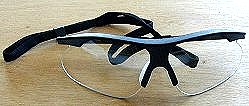 glasses
cost about four bucks. The problem is the glasses are in your
toolbox or under your workbench and you're too lazy or
forgetful to get them every time you use your drill, power
sander, chisel or planer.
glasses
cost about four bucks. The problem is the glasses are in your
toolbox or under your workbench and you're too lazy or
forgetful to get them every time you use your drill, power
sander, chisel or planer.The solution is simple. Buy a half-dozen pairs today and keep one hanging on each tool or piece of equipment in your work area that could injure your eyes. That way you'll have to pick up the safety glasses before you can use the equipment and it will become second nature to put them on.
WATERPROOF CONTAINER
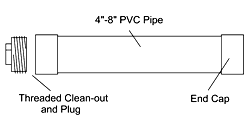 Make a waterproof container for your boat's
Certificate of Number/Registration/Insurance papers, tools,
snacks, etc. out of 3 or 4-inch PVC pipe. Glue a smooth,
permanent cap on one end, and keep a threaded removable plug or
cap on the other.
Make a waterproof container for your boat's
Certificate of Number/Registration/Insurance papers, tools,
snacks, etc. out of 3 or 4-inch PVC pipe. Glue a smooth,
permanent cap on one end, and keep a threaded removable plug or
cap on the other.That way it's easy to keep tools and other items dry and out of the way. It's easy to bungee cord it to the floor or side of your boat or fasten under the seat.
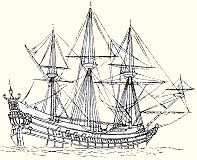
Recent email:
Subject: Thank You from a Veteran
Hello, I've been looking at your plans for a while now (I sent you an email about 1 or 2 weeks ago asking a question).Well I was not going to purchase a set of plans just yet because I'm not ready right now to begin building. When I went to your site today and noticed your support for the Wounded Warrior Project, that is what made up my mind to purchase now.
You see I'm a retired Veteran and I currently have a son in Iraq. Though I and other active and retired have our personal opinions on politics, the Soldiers, Sailors, Marines and Airmen should not be held responsible as we are only doing the job of keeping freedom for America.
Your support during this Memorial weekend is much appreciated by myself and I just wanted to say thank you.
-- Eric Morehouse
St. Robert, Missouri
Subject: Item of Interest
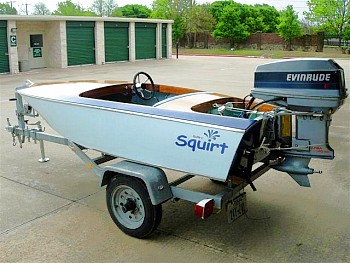 Here's an example of how
things evolve way beyond reason when folks have more money
than sense!!! As you know too well, the Squirt is rated
"conservatively" for a 10 horsepower motor... this
boat was powered with a KG-7 Merc (factory rated at 10 HP but
actually put out closer to 18 HP) before the SST45 (Evinrude
45 HP race engine) came along. This from a friend of mine in
Texas. I hope he can keep it right side up, 'cause this
Squirt is a prime specimen!!
Here's an example of how
things evolve way beyond reason when folks have more money
than sense!!! As you know too well, the Squirt is rated
"conservatively" for a 10 horsepower motor... this
boat was powered with a KG-7 Merc (factory rated at 10 HP but
actually put out closer to 18 HP) before the SST45 (Evinrude
45 HP race engine) came along. This from a friend of mine in
Texas. I hope he can keep it right side up, 'cause this
Squirt is a prime specimen!!
Enjoy, and don't cringe too much!!!
-- Dan Crummett
Stillwater, Oklahoma
Subject: Glen-L Gathering of Boatbuilders
Hello I was wondering when you have the date set for this year's Gathering at Lake Guntersville. I have attached a couple of images from last year's Gathering.Thanks.
-- Ty Smith
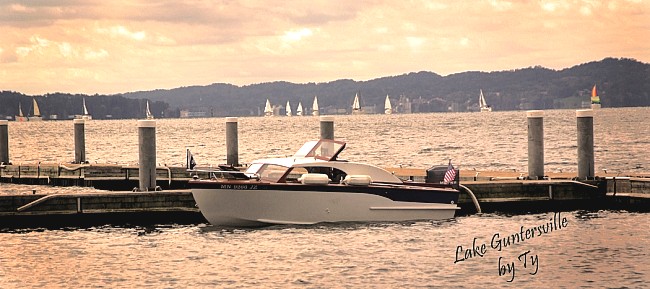
To learn more about the 2010 Gathering or to be more involved and even help with planning the event (if you wish), go to our Gathering page and the Boatbuilder Forum 2010 Gathering discussions.
See photos of all our past Gatherings here.
Subject: We're Having a Ball!!!
I had promised myself I'd never build another boat. My son looked at me one day and I realized he'd only be a young boy once. I've sent in a few pix of my 12 year old son and me working on it. He's quite Gung-Ho and we're having a ball!!! Thanks to Glen-L.
I've been around the internet, and no one designs boats like you. You should have for sale a small bronze Glen-L logo plaque that boat builders can attach to the topside. I know I'd buy one. It would probably read; "A Glen-L Design" and then underneath, small: "Bellflower, California."
I'd be proud to show it off.
-- Al Seymour
Sandys, Bermuda
Subject: Wanting to Build Another...
To make a longer story short, one of those all-too-famous hurricanes that we have down here took care of our Little MiniMost. I will be 62 next month November 15 and I have been wanting to build us another small runabout. We have not quite got our minds made up yet, but YOU BETTER KNOW IT WILL BE FROM Y'ALL.
We will be keeping in touch with you good folks.
-- Tommy and Kate Warden
Wiggins, Mississippi
A Fish Story
A guy who lives at Lake Conroe (50 miles north of
Houston ) saw a ball bouncing around kind of strange
in the lake and went to investigate.
I guess even catfish bite off more than they can chew sometimes... |
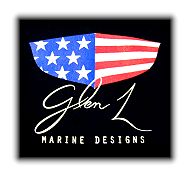
GLEN-L boats, of course


